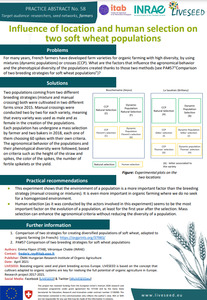{Tool} Influence of location and human selection on two soft wheat populations (Liveseed Practice Abstract). Creator(s): Flipon, Emma and Chable, Véronique. Issuing Organisation(s): ITAB - Institute for Organic Agriculture and Food, INRAE - National Research Institute for Agriculture, Food and Environment. Liveseed Practice abstract, no. 58. (2021)
|
PDF
- Published Version
- English
468kB | |
![[thumbnail of 2022-07-26 21_05_45-PowerPoint Presentation.png]](/39908/10.hassmallThumbnailVersion/2022-07-26%2021_05_45-PowerPoint%20Presentation.png)  Preview |
Image (PNG)
- Cover Image
- English
158kB |
Document available online at: https://www.liveseed.eu/wp-content/uploads/2021/04/PA58_Influence-of-location-and-human-selection-on-two-soft-wheat-populations.pdf
Summary in the original language of the document
Practical recommendations: This experiment shows that the environment of a population is a more important factor than the breeding strategy (manual crossing or mixtures). It is even more important in organic farming where we do no seek for a homogenized environment. Human selection (as it was conducted by the actors involved in this experiment) seems to be the most important factor on the evolution of a population, at least for the first year after the selection. Mass selection can enhance the agronomical criteria without reducing the diversity of a population.
| EPrint Type: | Practice tool |
|---|---|
| What problem does the tool address?: | For many years, French farmers have developed farm varieties for organic farming with high diversity, by using mixtures (dynamic populations) or crosses (CCP). What are the factors that influence the agronomical behavior and the phenotypical diversity of the populations created thanks to those two methods (see PA#57“Comparison of two breeding strategies for soft wheat populations”)? |
| What solution does the tool offer?: | Two populations coming from two different breeding strategies (mixture and manual crossing) both were cultivated in two different farms since 2015. Manual crossings were conducted two by two for each variety, meaning that every variety was used as male and as female in the creation of the populations. Each population has undergone a mass selection by farmer and two bakers in 2018, each one of them choosing 60 spikes with their own criteria. The agronomical behavior of the populations and their phenotypical diversity were followed, based on criteria such as the height of the straw and spikes, the color of the spikes, the number of fertile spikelets or the yield. |
| Country: | France |
| Type of Practice Tool: | Practice abstracts |
| Keywords: | plant breeding |
| Agrovoc keywords: | Language Value URI English plant breeding http://aims.fao.org/aos/agrovoc/c_5956 |
| Subjects: | Crop husbandry > Production systems > Cereals, pulses and oilseeds Crop husbandry > Breeding, genetics and propagation |
| Research affiliation: | European Union > Horizon 2020 > Liveseed European Union > Horizon 2020 > Liveseed > Liveseed tools France > INRAe - Institut national de recherche pour l’agriculture, l’alimentation et l’environnement France > ITAB - Institut Technique en Agriculture Biologique European Union > Organic Farm Knowledge |
| Horizon Europe or H2020 Grant Agreement Number: | 727230 |
| Related Links: | https://organic-farmknowledge.org/tool/39908 |
| Project ID: | ofk |
| Deposited By: | Ortolani, Dr. Livia |
| ID Code: | 39908 |
| Deposited On: | 28 May 2021 09:05 |
| Last Modified: | 02 May 2024 10:32 |
| Document Language: | English |
| Status: | Published |
Repository Staff Only: item control page

 Download Statistics
Download Statistics Download Statistics
Download Statistics
